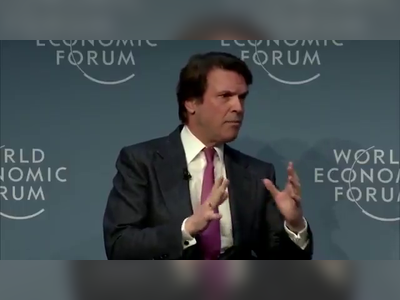
Why Aren’t We Wearing Better Masks?
Cloth masks are better than nothing, but they were supposed to be a stopgap measure.
If you’re like most Americans, there’s a good chance you’re going to wear a cloth mask today. Doing so makes sense. It remains the official recommendation in the United States, and it is something we’ve both advocated since the beginning of the pandemic. Both of us wrote articles as far back as March urging people to wear homemade cloth masks.
We’re also the authors (along with 17 other experts) of a paper titled “An Evidence Review of Face Masks Against COVID,” which was just published in peer-reviewed form in the Proceedings of the National Academy of Sciences. But it’s past time for better solutions to be available to the public.
We first released the paper as a preprint back in April, and it took nine months to go through peer review. We’re happy that it’s published but, to be honest, we’re also deeply disappointed that it’s still relevant.
We’d hoped that by 2021 supply chains would have ramped up enough to ensure that everyone had better masks. Cloth masks, especially homemade ones, were supposed to be a stopgap measure. Why are so many of us still wearing them?
Don’t get us wrong; everything we said about the efficacy of cloth masks stands the test of time. Wearing them is much better than wearing nothing. They definitely help reduce transmission of the coronavirus from the wearer and likely protect the wearer to some degree as well.
But we know that not all masks are equal, and early on in the pandemic, there was a dire shortage of higher-grade masks for medical workers. During those emergency conditions, something was much better than nothing. There are better possibilities now, but they require action and guidance by the authorities.
Even all cloth masks are not equal. Construction, materials, and fit matter, and these can’t be tracked or certified with homemade masks. Unlike cloth masks, medical-grade masks (also called respirators) that adhere to standards such as N95 (in the U.S.), FFP2 (in the European Union), and KN95 (in China) do a much better job of protecting the wearer and dampening transmission. Ideally, they should also come with instructions on how to wear them and ensure that they fit properly.
Because we have written about masks, we’ve become informal advisers to friends, family, and strangers on the internet. We’re not much help, though. When our friends ask us simple questions like “Where should I buy a mask?” or “Is my mask any good?,” we don’t have great answers. We can mumble generalities: Make sure it fits well; here are some guidelines about layers; try to avoid fake N95s. But if we can’t give wholly satisfying answers to such basic questions, then how is the general public expected to fare?
Tragically, America is swamped with fraudulent medical-grade masks, some of which are only 1 percent effective. Many masks do not have labels clearly indicating their manufacturer. Some official mask-testing methods are inappropriate, including the use of far higher pressure than normal breathing exerts.
No reasonable certification is available for the most useful masks generally available to the public. All of this means that everyone has to somehow figure out for themselves which masks are effective.
We routinely get PR pitches for excellent new solutions as well as snake-oil remedies, and we sometimes have trouble telling them apart—how is an ordinary person supposed to evaluate competing claims? When we share our articles about masks on social media, we are asked where to buy proper masks.
Not only do we have no answer, but we often find that marketers will answer instead, directing readers to unreliable, overpriced masks. Worse, the supply situation apparently remains so dire that the CDC still “does not recommend that the general public wear N95 respirators,” because they’re crucial supplies that must continue to be reserved for health-care workers and other first responders.
Not all countries have this problem. Taiwan massively scaled up its manufacturing of masks at the start of 2020, such that by April every citizen received a fresh supply of high-quality masks each week, and the distribution system was regulated by the government.
Taiwan’s COVID-19 death rate per capita is more than 1,000 times lower than that in the U.S. Hong Kong has been distributing patented six-layer masks (the efficacy of which has been laboratory tested) to every citizen.
Singapore is on at least its fourth round of distributing free, reusable, multilayer masks with filters to everyone—even kids, who get kid-size ones. In Germany, Bavaria has just announced that it will be requiring higher-grade masks. If all of these places can do this, why can’t we?
Fixing this problem is more urgent now that a new variant of the coronavirus, known as the B.1.1.7 lineage, is making its way around the world. This variant is believed to be about 50 to 70 percent more transmissible than earlier strains of the virus. Masks are an important part of the battle against this new variant because they decrease transmission by reducing the number of infectious particles spread by a mask wearer (known as “source control”) and by reducing the amount that a mask wearer inhales.
The cloth masks that we focus on in our paper do a good job at source control, but on their own they do not protect the wearer as well as medical-grade respirators do. That’s why health-care workers wear respirators, and that’s why leaving existing supplies for them was important early on—they were dealing directly with COVID-19 patients, so they needed the protection.
Right now, while the CDC language on supply shortages has not been updated, it’s unclear if that’s because the shortages are really that dire or because this topic has not been paid sufficient attention. In either case, the CDC should update us on the situation. And if, indeed, we are still suffering from shortages, emergency measures should finally be implemented to manufacture such masks at home.
Not having higher-grade medical masks or even reliable, certified cloth masks distributed to the population means more transmission. But that’s not all. If we could confidently tell people that the masks would also help protect the wearer from infection, we would likely get more people to wear them. Appealing to solidarity is excellent (“My mask protects you; your mask protects me”), but being able to confidently add self-interest to the equation would be even better.
Ideally we would have ramped up supply and been able to produce and distribute certified higher-filtration masks to the whole population. At a minimum, we should have created a certification program and a distribution channel that allows people to purchase higher-grade masks with confidence. Even better, we could have distributed them to the public for free like so many other places.
It’s not just that many other countries showed us the way: Many experts have been urging a switch to better-grade masks as soon as possible. For example, Abraar Karan and his co-authors wrote on the same topic many, many times, in May, June, October, and even this month. As Karan pointed out to us, the fact that some people refuse to wear masks makes it even more imperative that we distribute higher-grade masks to those willing to wear them.
We need the CDC and the FDA to step up and provide simple, clear, actionable, and specific information that would allow the public to know which masks are reliable and where they can get them, as well as how to upgrade and better wear their existing options. Initial studies suggest that widely available surgical masks, combined with a mask brace, could increase the effectiveness of the surgical masks.
Cloth masks can be upgraded with a nose wire (for fit) and a filter insert—and more than 100,000 types of these masks are available on Etsy. A good supply of KN95 masks is available from China, with many supermarkets and pharmacies now selling them for a couple of dollars each. But none of these solutions can work widely as long as the public has little guidance on which masks are reliable and certified.
When, three months ago, one of us found FDA-certified KN95 masks at a local supermarket, she was shocked that they were just sitting in a large bin, next to similarly priced single-layer cloth masks. There was no run on them, because the public was not informed of their importance.
When she spread word of the masks on social media, hoping some locals would be able to take advantage of this chance, she was inundated by people asking whether they were fake—a valid concern, given that the country is awash in fake masks. She ended up purchasing a bunch to distribute, an effort that would have been comical if it weren’t so tragic.
One person reached out to say that his fiancée was about to undergo an organ transplant and was expected to do her rehabilitation wearing only cloth masks. A handoff of medical-grade masks was arranged. To an observer, it might have looked like a drug deal: people exiting their cars in a parking lot, searching for someone they clearly had not met before; both looking at the cars around them and their phone until they managed to meet up. Finally, a package was handed over, cash was offered but refused—an agreement was struck to pay it forward with a favor to someone else—and a relieved-looking man took the package back to his car and drove off. But it was much worse than a drug deal, the whole episode proof of a disastrous public-health breakdown in the United States.
We’re also the authors (along with 17 other experts) of a paper titled “An Evidence Review of Face Masks Against COVID,” which was just published in peer-reviewed form in the Proceedings of the National Academy of Sciences. But it’s past time for better solutions to be available to the public.
We first released the paper as a preprint back in April, and it took nine months to go through peer review. We’re happy that it’s published but, to be honest, we’re also deeply disappointed that it’s still relevant.
We’d hoped that by 2021 supply chains would have ramped up enough to ensure that everyone had better masks. Cloth masks, especially homemade ones, were supposed to be a stopgap measure. Why are so many of us still wearing them?
Don’t get us wrong; everything we said about the efficacy of cloth masks stands the test of time. Wearing them is much better than wearing nothing. They definitely help reduce transmission of the coronavirus from the wearer and likely protect the wearer to some degree as well.
But we know that not all masks are equal, and early on in the pandemic, there was a dire shortage of higher-grade masks for medical workers. During those emergency conditions, something was much better than nothing. There are better possibilities now, but they require action and guidance by the authorities.
Even all cloth masks are not equal. Construction, materials, and fit matter, and these can’t be tracked or certified with homemade masks. Unlike cloth masks, medical-grade masks (also called respirators) that adhere to standards such as N95 (in the U.S.), FFP2 (in the European Union), and KN95 (in China) do a much better job of protecting the wearer and dampening transmission. Ideally, they should also come with instructions on how to wear them and ensure that they fit properly.
Because we have written about masks, we’ve become informal advisers to friends, family, and strangers on the internet. We’re not much help, though. When our friends ask us simple questions like “Where should I buy a mask?” or “Is my mask any good?,” we don’t have great answers. We can mumble generalities: Make sure it fits well; here are some guidelines about layers; try to avoid fake N95s. But if we can’t give wholly satisfying answers to such basic questions, then how is the general public expected to fare?
Tragically, America is swamped with fraudulent medical-grade masks, some of which are only 1 percent effective. Many masks do not have labels clearly indicating their manufacturer. Some official mask-testing methods are inappropriate, including the use of far higher pressure than normal breathing exerts.
No reasonable certification is available for the most useful masks generally available to the public. All of this means that everyone has to somehow figure out for themselves which masks are effective.
We routinely get PR pitches for excellent new solutions as well as snake-oil remedies, and we sometimes have trouble telling them apart—how is an ordinary person supposed to evaluate competing claims? When we share our articles about masks on social media, we are asked where to buy proper masks.
Not only do we have no answer, but we often find that marketers will answer instead, directing readers to unreliable, overpriced masks. Worse, the supply situation apparently remains so dire that the CDC still “does not recommend that the general public wear N95 respirators,” because they’re crucial supplies that must continue to be reserved for health-care workers and other first responders.
Not all countries have this problem. Taiwan massively scaled up its manufacturing of masks at the start of 2020, such that by April every citizen received a fresh supply of high-quality masks each week, and the distribution system was regulated by the government.
Taiwan’s COVID-19 death rate per capita is more than 1,000 times lower than that in the U.S. Hong Kong has been distributing patented six-layer masks (the efficacy of which has been laboratory tested) to every citizen.
Singapore is on at least its fourth round of distributing free, reusable, multilayer masks with filters to everyone—even kids, who get kid-size ones. In Germany, Bavaria has just announced that it will be requiring higher-grade masks. If all of these places can do this, why can’t we?
Fixing this problem is more urgent now that a new variant of the coronavirus, known as the B.1.1.7 lineage, is making its way around the world. This variant is believed to be about 50 to 70 percent more transmissible than earlier strains of the virus. Masks are an important part of the battle against this new variant because they decrease transmission by reducing the number of infectious particles spread by a mask wearer (known as “source control”) and by reducing the amount that a mask wearer inhales.
The cloth masks that we focus on in our paper do a good job at source control, but on their own they do not protect the wearer as well as medical-grade respirators do. That’s why health-care workers wear respirators, and that’s why leaving existing supplies for them was important early on—they were dealing directly with COVID-19 patients, so they needed the protection.
Right now, while the CDC language on supply shortages has not been updated, it’s unclear if that’s because the shortages are really that dire or because this topic has not been paid sufficient attention. In either case, the CDC should update us on the situation. And if, indeed, we are still suffering from shortages, emergency measures should finally be implemented to manufacture such masks at home.
Not having higher-grade medical masks or even reliable, certified cloth masks distributed to the population means more transmission. But that’s not all. If we could confidently tell people that the masks would also help protect the wearer from infection, we would likely get more people to wear them. Appealing to solidarity is excellent (“My mask protects you; your mask protects me”), but being able to confidently add self-interest to the equation would be even better.
Ideally we would have ramped up supply and been able to produce and distribute certified higher-filtration masks to the whole population. At a minimum, we should have created a certification program and a distribution channel that allows people to purchase higher-grade masks with confidence. Even better, we could have distributed them to the public for free like so many other places.
It’s not just that many other countries showed us the way: Many experts have been urging a switch to better-grade masks as soon as possible. For example, Abraar Karan and his co-authors wrote on the same topic many, many times, in May, June, October, and even this month. As Karan pointed out to us, the fact that some people refuse to wear masks makes it even more imperative that we distribute higher-grade masks to those willing to wear them.
We need the CDC and the FDA to step up and provide simple, clear, actionable, and specific information that would allow the public to know which masks are reliable and where they can get them, as well as how to upgrade and better wear their existing options. Initial studies suggest that widely available surgical masks, combined with a mask brace, could increase the effectiveness of the surgical masks.
Cloth masks can be upgraded with a nose wire (for fit) and a filter insert—and more than 100,000 types of these masks are available on Etsy. A good supply of KN95 masks is available from China, with many supermarkets and pharmacies now selling them for a couple of dollars each. But none of these solutions can work widely as long as the public has little guidance on which masks are reliable and certified.
When, three months ago, one of us found FDA-certified KN95 masks at a local supermarket, she was shocked that they were just sitting in a large bin, next to similarly priced single-layer cloth masks. There was no run on them, because the public was not informed of their importance.
When she spread word of the masks on social media, hoping some locals would be able to take advantage of this chance, she was inundated by people asking whether they were fake—a valid concern, given that the country is awash in fake masks. She ended up purchasing a bunch to distribute, an effort that would have been comical if it weren’t so tragic.
One person reached out to say that his fiancée was about to undergo an organ transplant and was expected to do her rehabilitation wearing only cloth masks. A handoff of medical-grade masks was arranged. To an observer, it might have looked like a drug deal: people exiting their cars in a parking lot, searching for someone they clearly had not met before; both looking at the cars around them and their phone until they managed to meet up. Finally, a package was handed over, cash was offered but refused—an agreement was struck to pay it forward with a favor to someone else—and a relieved-looking man took the package back to his car and drove off. But it was much worse than a drug deal, the whole episode proof of a disastrous public-health breakdown in the United States.
AI Disclaimer: An advanced artificial intelligence (AI) system generated the content of this page on its own. This innovative technology conducts extensive research from a variety of reliable sources, performs rigorous fact-checking and verification, cleans up and balances biased or manipulated content, and presents a minimal factual summary that is just enough yet essential for you to function as an informed and educated citizen. Please keep in mind, however, that this system is an evolving technology, and as a result, the article may contain accidental inaccuracies or errors. We urge you to help us improve our site by reporting any inaccuracies you find using the "Contact Us" link at the bottom of this page. Your helpful feedback helps us improve our system and deliver more precise content. When you find an article of interest here, please look for the full and extensive coverage of this topic in traditional news sources, as they are written by professional journalists that we try to support, not replace. We appreciate your understanding and assistance.











